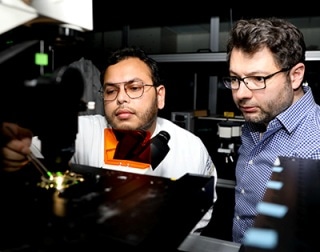Oct 22 2019
Ultrasensitive nanoscale optical probes have been created by scientists from UC Santa Cruz, to observe the bioelectric activity of neurons and other excitable cells.
 UC Santa Cruz engineers Ahsan Habib (left) and Ali Yanik have developed ultrasensitive nanoscale optical probes to monitor the bioelectric activity of neurons and other electrogenic cells. (Image credit: C. Lagattuta)
UC Santa Cruz engineers Ahsan Habib (left) and Ali Yanik have developed ultrasensitive nanoscale optical probes to monitor the bioelectric activity of neurons and other electrogenic cells. (Image credit: C. Lagattuta)
This innovative readout technology could allow researchers to analyze how neural circuits operate at a scale like never before, by observing large numbers of individual neurons at the same time. It could also pave the way for high-bandwidth brain-machine interfaces with drastically increased functionality and precision.
Traditionally, the electrical activity of neurons is monitored with the help of microelectrode arrays. However, these components are challenging to implement at a large scale and provide limited spatial resolution.
According to Ali Yanik, assistant professor of electrical and computer engineering at UCSC’s Baskin School of Engineering, the electronic wiring needed for readout is a key limitation of microelectrodes.
The extremely limited bandwidth of the electronic wiring is a bottleneck created by the very nature of electrons. We turn to photons because light offers billion-fold enhanced multiplexing and information carrying capabilities, the same reason why the telecommunication industry moved to fiber optics. By converting bioelectric signals to photons, we will be able to transmit large-bandwidth neural activity optically.
Ali Yanik, Assistant Professor of Electrical and Computer Engineering, Baskin School of Engineering, UC Santa Cruz
Collaborating with colleagues from the University of Notre Dame, Yanik’s lab has created extracellular nanoprobes that facilitate ultrasensitive optical monitoring of electrophysiological signals. Other techniques for performing optical monitoring necessitate genetic modifications to inject fluorescent molecules into cell membranes, which inhibits their use in humans.
Yanik’s technique is similar to extracellular microelectrode techniques, but only that the probes have nanoscale dimensions and the readout mechanism is optical. Furthermore, it produces a considerably brighter signal and higher signal-to-noise ratios compared to fluorescence-based probes.
“Harnessing the unparalleled multiplexing and information-carrying capability of light to dissect the neural circuitry and decrypt electrophysiological signals has been a goal of neuroscientists for nearly 50 years. We may have finally found a way to do that,” stated Yanik.
The new technology has been explained in a paper published in Science Advances on October 18th, 2019. The first author of the paper is Ahsan Habib, a PhD candidate in Yanik’s lab.
Broad Applications
The technology is still in its infancy, but according to Yanik, it could pave the way for a broad array of applications. Eventually, it could lead to robust brain-machine interfaces, allowing new brain-controlled prosthetic technologies to be developed for people with disabilities.
The optical nanoprobes developed by Yanik are nanoscale devices (with a diameter of <100 nm) based on an innovative metallic antenna structure connected to a biocompatible polymer known as PEDOT. This polymer is “electro-chromic,” that is, its optical properties vary based on the local electric field.
The antenna is a “plasmonic nanoantenna,” that is, it uses nanoscale interactions of matter and light similar to a radio antenna. The outcome is an “electro-plasmonic nanoantenna” that offers reliable optical detection of local electric field dynamics with extremely high sensitivity.
The electro-plasmonic nanoantenna has a resonance frequency that changes in response to the electric field, and we can see that when we shine light on it, so we can read the signal remotely.
Ali Yanik, Assistant Professor of Electrical and Computer Engineering, Baskin School of Engineering, UC Santa Cruz
The researchers carried out a range of laboratory experiments for characterizing and optimizing the properties of the electro-plasmonic nanoantenna. Then, they tested its potential to monitor electrophysiological signals in cell cultures of cardiomyocytes (heart muscle cells which, similar neurons, can produce electrical impulses). The outcomes demonstrated real-time, all-optical detection of electrical activity in cardiomyocytes, with high signal-to-noise ratios.
Apart from eliminating the need for genetic manipulations, the benefits of this method over fluorescent probes include the very low light intensities required, and two to three orders of magnitude lower than the usual light intensities used for fluorescent voltage probes. Moreover, the fluorescent molecules are vulnerable to bleaching and produce disruptive oxygen-free radicals.
Yanik came up with two probable techniques for applying the optical nanoprobes to monitor neural activity in living animals, such as humans. The probes could be combined with an optical fiber and placed into a biocompatible and flexible implant, or they could be produced as nanoparticles suspended in a colloidal solution, where surface proteins are attached to allow the probes to bind to particular types of cells.
“With the solution-based system, you could inject it into the bloodstream or into an organ, and the nanoprobes attach to the specific cell types you want to monitor,” stated Yanik. “We are just at the beginning stages of this, but I think we have a good foundation to build on.”
A vital reason for using neural probes in living animals is the intrinsic immune response to foreign materials within the body. Earlier studies have demonstrated that when electrodes are coated with the biocompatible PEDOT polymer, the long-term performance of microfabricated neural prosthetic devices is drastically improved. Moreover, the size of implants has an effect on the immune response.
The critical feature sizes are 10 to 15 microns. Recent studies have shown that smaller size implants lead to dramatically reduced inherent immune response. In this sense, our PEDOT-coated probes with nanoscale dimensions are particularly advantageous for long-term operation.
Ahsan Habib, PhD Candidate, Baskin School of Engineering, UC Santa Cruz
Apart from Habib and Yanik, the coauthors of the study include UCSC graduate students Xiangchao Zhu and Maverick McLanahan, and Uryan Can and Pinar Zorlutuna from the University of Notre Dame. This study was supported by grants from the National Science Foundation.